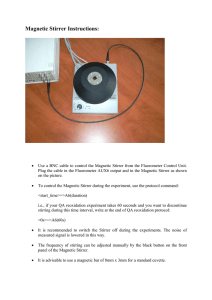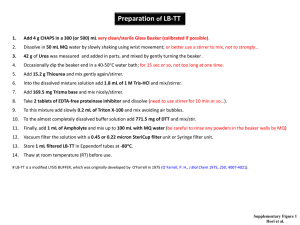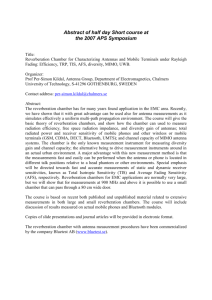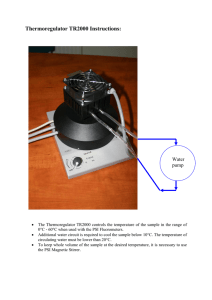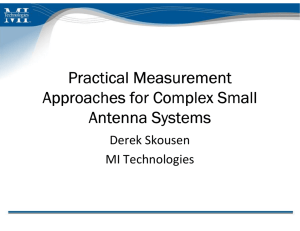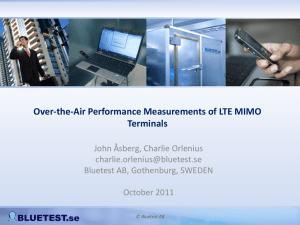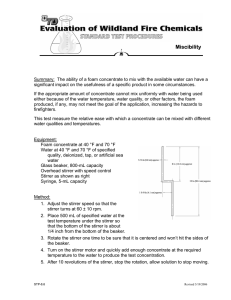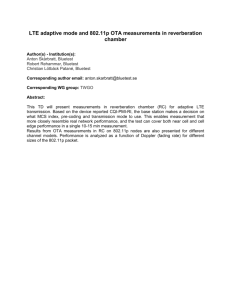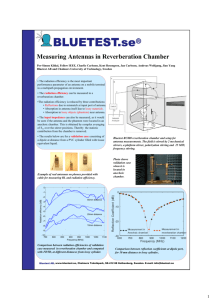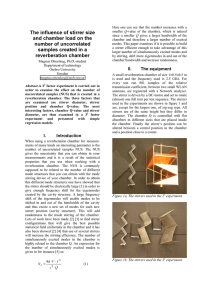Experimental Field Statistics Validation in a Cubic Reverberation
advertisement
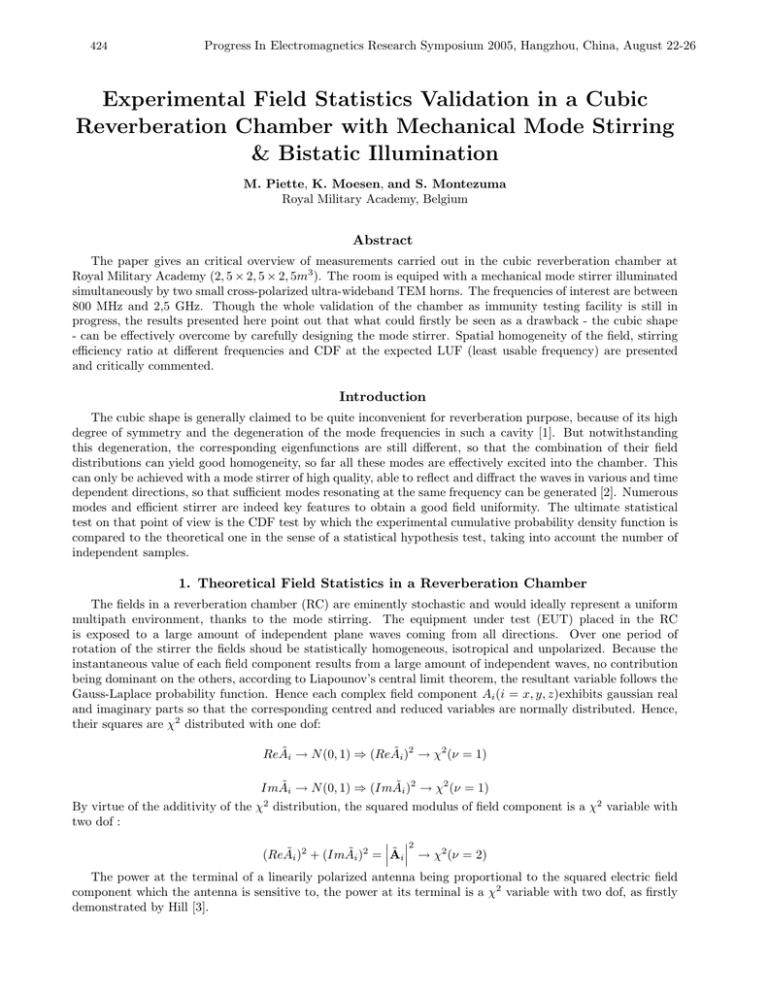
424 Progress In Electromagnetics Research Symposium 2005, Hangzhou, China, August 22-26 Experimental Field Statistics Validation in a Cubic Reverberation Chamber with Mechanical Mode Stirring & Bistatic Illumination M. Piette, K. Moesen, and S. Montezuma Royal Military Academy, Belgium Abstract The paper gives an critical overview of measurements carried out in the cubic reverberation chamber at Royal Military Academy (2, 5 × 2, 5 × 2, 5m3 ). The room is equiped with a mechanical mode stirrer illuminated simultaneously by two small cross-polarized ultra-wideband TEM horns. The frequencies of interest are between 800 MHz and 2,5 GHz. Though the whole validation of the chamber as immunity testing facility is still in progress, the results presented here point out that what could firstly be seen as a drawback - the cubic shape - can be effectively overcome by carefully designing the mode stirrer. Spatial homogeneity of the field, stirring efficiency ratio at different frequencies and CDF at the expected LUF (least usable frequency) are presented and critically commented. Introduction The cubic shape is generally claimed to be quite inconvenient for reverberation purpose, because of its high degree of symmetry and the degeneration of the mode frequencies in such a cavity [1]. But notwithstanding this degeneration, the corresponding eigenfunctions are still different, so that the combination of their field distributions can yield good homogeneity, so far all these modes are effectively excited into the chamber. This can only be achieved with a mode stirrer of high quality, able to reflect and diffract the waves in various and time dependent directions, so that sufficient modes resonating at the same frequency can be generated [2]. Numerous modes and efficient stirrer are indeed key features to obtain a good field uniformity. The ultimate statistical test on that point of view is the CDF test by which the experimental cumulative probability density function is compared to the theoretical one in the sense of a statistical hypothesis test, taking into account the number of independent samples. 1. Theoretical Field Statistics in a Reverberation Chamber The fields in a reverberation chamber (RC) are eminently stochastic and would ideally represent a uniform multipath environment, thanks to the mode stirring. The equipment under test (EUT) placed in the RC is exposed to a large amount of independent plane waves coming from all directions. Over one period of rotation of the stirrer the fields shoud be statistically homogeneous, isotropical and unpolarized. Because the instantaneous value of each field component results from a large amount of independent waves, no contribution being dominant on the others, according to Liapounov’s central limit theorem, the resultant variable follows the Gauss-Laplace probability function. Hence each complex field component Ai (i = x, y, z)exhibits gaussian real and imaginary parts so that the corresponding centred and reduced variables are normally distributed. Hence, their squares are χ2 distributed with one dof: ReÃi → N (0, 1) ⇒ (ReÃi )2 → χ2 (ν = 1) ImÃi → N (0, 1) ⇒ (ImÃi )2 → χ2 (ν = 1) By virtue of the additivity of the χ2 distribution, the squared modulus of field component is a χ2 variable with two dof : 2 (ReÃi )2 + (ImÃi )2 = Ãi → χ2 (ν = 2) The power at the terminal of a linearily polarized antenna being proportional to the squared electric field component which the antenna is sensitive to, the power at its terminal is a χ2 variable with two dof, as firstly demonstrated by Hill [3]. Progress In Electromagnetics Research Symposium 2005, Hangzhou, China, August 22-26 425 2. The LEMA Reverberation Chamber The LEMA facility is a small Faraday cage converted into an experimental RC (Photo 1). The room is a cube of 2,48 m a side. The cage is designed up to 10 GHz. With 2,48 m on a side the fundamental resonance of the chamber occurs at 85,15 MHz (TE011 , TE101 and TM110 modes). The stirrer’s total length is 2,25 m. It consists of four sections of copper plate assemblies. All sections have an overall width of 0,4 m to make them electrically large at the frequencies of interest. The sections are made of different lengths and with various angles between the plates to optimize reflection diversity of the impinging waves. Photo 1: The LEMA cubic Faraday cage The stirrer is mechanically steered by a step motor (Photo 2). Normally its axis is mounted vertically to prevent from bending stress and is placed in the corner to leave as much place as possible for testing EUT, but it has also be tested in horizontal position. According to the “factor 6” rule of thumb usually considered as the minimum ratio of the testing frequency to the fundamental resonance frequency to have enough modes in the cavity [4], the expected lowest usable frequency of the chamber on that point of view should be 500MHz. Now, because of the relatively small dimensions of the cavity, the stirrer cannot be made as large as one could wish. Knowing that a stirrer has to be at least 2,4 wavelength long to obtain a good spatial field uniformity in the chamber [4], the expected lowest usable frequency (LUF) for efficient mode stirring is more probably about 1800 MHz. Photo 2: The LEMA Reverberation Chamber with stirrer in horizontal position and driving step moto Figure 1: Time dependent aspect of the rotating stirrer facing the sources 3.Measurement Set-up and Procedure The three components of the electric field are measured separately by means of a small broadband triaxial probe - Mélopée ET2003 - operating from 10 kHz to 2,5 GHz (Photo 3). Fieldstrength up to 20 V/m can be 426 Progress In Electromagnetics Research Symposium 2005, Hangzhou, China, August 22-26 sensed. The probe is coupled to an integrated electro-optical converter, a laser diode transmitting the optical signal to a 3 channels opto-electrical receiver. The electrical outpout signal is then measured by means of a spectrum analyzer. It is also possible to connect a network analyzer as reveiver and to use a broadband double ridge horn for sensing the fields at higher frequencies (0,9-18 GHz) Photo 3: Triaxial probe (7.0×8.4×8.5 cm) & optical reveiver coupled to spectrum analyser 4. Measured Field Statistics in the LEMA Reverberation Chamber A first set of measurements have been carried out to assess the spatial field homogeneity in the chamber at high frequency (2GHz), i.e. above the expected LUF. The ridge horn has been set in 23 different locations at 1,2 m above ground and the maximum fieldstrength obtained over one stirrer rotation has been registred, firstly without the stirrer (Fig. 2a) and then with the stirrer in operation (Fig. 2b). Without stirrer, only 9 of the 23 measurement positions (39%) are within the ±3dB tolerance and the spatial variation can be as high as 22 dB. In such an environment the equipment under test (EUT) would not be uniformly illuminated. When the stirrer is in operation, it turns out that 12 positions of the 16 measurement points (75%) are in the ±3dB tolerance and the spatial standard deviation σ defined as follows is only 1,36. σnum + hEi σ (dB) = 20 log = 1, 36 hEi Figure 2: Spatial field homogeneity without (a) and with stirrer (b) The same measurements have been then repeated at 900 MHz i.e. two times lower than the expected LUF and only 54 % of the data points turn out to be still within tolerance. In a second step the stirring ratio (SR) at the centre of the cavity has been determined in the 900-2500 MHz range (Fig. 3). The SR is defined as the ratio between the maximum and the minimum powers received by the test antenna over one stirrer rotation. This figure ought to be at least 20 dB for good stirring performance. It turns out that above 1500 MHz the SR is still above 20 dB, while its value falls off under this threshold at some lower frequencies. Finally the S21 parameter of the two-port formed by the transmitting antenna, the reverberation chamber and the receiving antenna has been measured in nine different locations of the receiving antenna and for 200 positions of the mode stirrer in each antenna location. The experimental cumulative probability density function (CDF) of this S21 parameter has then been plotted and compared to the theoretical one. The results obtained Progress In Electromagnetics Research Symposium 2005, Hangzhou, China, August 22-26 427 Figure 3: Stirring ratio at the centre of the cavity over the frequency band of interest at 1800 MHz are depicted in Fig. 4. All the experimental CDF curves turn out to succeed the Kolmogorov test with 200 samples at a confidence level of 95%. Figure 4: Cumulative density function of the S21 parameter at 1800 MHz in different locations Conclusion Even in a cubic reverberation chamber it is possible to achieve good statistic field homogeneity by carefully designing the mechanical mode stirrer. Key design factors are its electrical size, the variety of reflecting and diffracting plates and the time dependence of its aspect as seen by the illuminators during the rotation. The LEMA chamber where such factors have been taken into account exhibits satisfactory performances w.r. stirring ratio, field homogeneity and CDF for frequencies above 1800 MHz, which enables to test the immunity of EUT operated in the bands of DCS1800 and UMTS cellular mobile systems. REFERENCES 1. Leferink & van Etten, “Optimal Utilization of a Reverberation Chamber,” EMC Symp., Bruges, Belgium, Vol. 1, 2000. 2. Piette, “From Cubic Faraday Cage to HIRF Testing Reverberation Chamber,” EuroEM 2004, Magdebourg, Germany, 2004. 3. Hill, “Plane Wave Integral Representation for Fields in Reverberation Chambers,” IEEE Trans. EMC, Vol.4 0, No. 3, 209-216, 1998. 4. Wu, Chang, “The Effect of an Electrically Large Stirrer in a Mode Stirred Chamber,” IEEE Trans. on EMC, Vol. 31, No. 2, 164-169, 1989.
